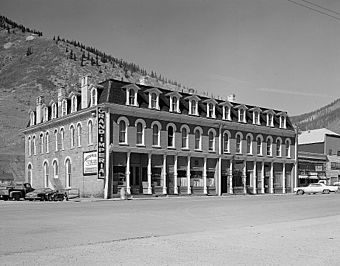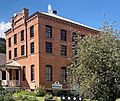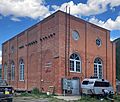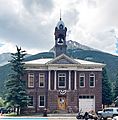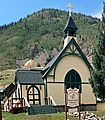Silverton, Colorado facts for kids
Quick facts for kids
Silverton, Colorado
|
|
|---|---|
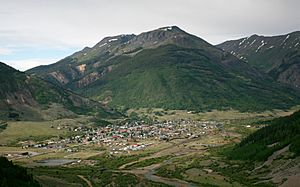 |
|
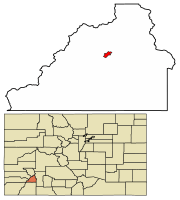
Location of Silverton in San Juan County, Colorado.
|
|
| Country | |
| State | |
| County | San Juan County - seat |
| Established | September 15, 1874 |
| Incorporated | November 15, 1885 |
| Government | |
| • Type | Statutory Town |
| Area | |
| • Total | 0.83 sq mi (2.16 km2) |
| • Land | 0.83 sq mi (2.16 km2) |
| • Water | 0.00 sq mi (0.00 km2) |
| Elevation | 9,302 ft (2,835 m) |
| Population
(2020)
|
|
| • Total | 622 |
| • Density | 749/sq mi (288.0/km2) |
| Time zone | UTC-7 (Mountain (MST)) |
| • Summer (DST) | UTC-6 (MDT) |
| ZIP code |
81433 (PO Box)
|
| Area code(s) | 970 |
| FIPS code | 08-70580 |
| GNIS feature ID | 2413289 |
Silverton is a small town in Colorado, United States. It is the main town in San Juan County. Silverton is found in the remote San Juan Mountains, which are part of the Rocky Mountains.
Miners first looked for gold in the mountains near Silverton in 1860. At that time, the Ute Tribe still controlled the land. Silverton was officially started after the Utes gave up the area in 1873. The town grew quickly because of silver mining. When the price of silver dropped in 1893, the town slowed down. It boomed again with gold mining until 1907.
Today, the entire town of Silverton is a special place. It is called the Silverton Historic District. This means it is protected as a National Historic Landmark District because of its important history.
Silverton was first called "Bakers Park." It sits in a flat area of the Animas River valley. Tall mountain peaks surround the town. Many of these peaks are over 13,000 feet high. Storm Peak is the tallest at 13,487 feet. Silverton is close to many of Colorado's highest mountains. It is a popular spot for exploring the mountains.
The last mine in Silverton closed in 1992. Now, the town mostly relies on visitors. People also work on projects to fix and protect the historic areas. Silverton is famous for the Durango and Silverton Narrow Gauge Railroad. This old train used to carry mining goods. Now, it is a National Historic Landmark and a popular tourist attraction. Silverton also hosts big events, like the Hardrock Hundred Mile Endurance Run. In 2020, 622 people lived in Silverton.
Contents
Silverton's Rich History
Early Discoveries and Mining Booms
In 1860, a group led by Charles Baker found small amounts of gold in the San Juan Mountains. The Ute Tribe made them leave in 1861. The Utes had been given this land in a treaty with the U.S. government.
Miners returned in 1871. They found more gold in a place called Arrastre Gulch. The miners were allowed to stay after the Brunot Treaty of 1873. In this agreement, the Ute Tribe gave up a large area of land. In return, they received money each year.
In 1873, George Howard and R.J. McNutt found a large silver deposit. This was near Hurricane Peak. Gold was also found there in 1882. The Sunnyside Mine was a very important mine. It closed after the Wall Street Crash of 1929.
The Sunnyside Mine and Its Challenges
The Sunnyside Mine reopened in 1959. It found more gold in 1973. During the 1970s, half of all the gold from Colorado came from this mine.
A big event happened on June 4, 1978. Water from Lake Emma broke into a mine shaft. The water rushed through the tunnels. It shot out of an opening near Cement Creek with great force. It even knocked over a 20-ton train engine.
The mine reopened after two years. It was bought by Echo Bay Mines in 1986. They ran the mine for five more years. In 2015, another nearby mine, the Gold King mine, had a spill. It released waste water into Cement Creek.
Population of Silverton
| Historical population | |||
|---|---|---|---|
| Census | Pop. | %± | |
| 1900 | 1,360 | — | |
| 1910 | 2,153 | 58.3% | |
| 1920 | 1,150 | −46.6% | |
| 1930 | 1,301 | 13.1% | |
| 1940 | 1,127 | −13.4% | |
| 1950 | 1,375 | 22.0% | |
| 1960 | 822 | −40.2% | |
| 1970 | 797 | −3.0% | |
| 1980 | 794 | −0.4% | |
| 1990 | 716 | −9.8% | |
| 2000 | 531 | −25.8% | |
| 2010 | 637 | 20.0% | |
| 2020 | 622 | −2.4% | |
Who Lives in Silverton?
According to the census in 2000, 531 people lived in Silverton. There were 255 households. About 24.7% of households had children under 18. Most people in Silverton were White. About 7.72% of the population was Hispanic or Latino.
The average age of people in Silverton was 44 years old. About 20.7% of residents were under 18. The local school system had 53 students from kindergarten to 12th grade in 2006.
Silverton's Geography and Climate
Where is Silverton Located?
Silverton is a very high town in the United States. It is about 9,318 feet (2,836 meters) above sea level. The town covers about 0.8 square miles (2.1 square kilometers) of land. The book "The Christopher Killer" takes place in Silverton.
Silverton's Weather
Silverton has a cold, snowy climate. Winters are very cold with lots of snow. Summers are cool to warm. It rains or snows throughout the year.
| Climate data for 1906-2005 Silverton, Colorado. | |||||||||||||
|---|---|---|---|---|---|---|---|---|---|---|---|---|---|
| Month | Jan | Feb | Mar | Apr | May | Jun | Jul | Aug | Sep | Oct | Nov | Dec | Year |
| Mean daily maximum °F (°C) | 34.0 (1.1) |
36.6 (2.6) |
40.6 (4.8) |
47.3 (8.5) |
57.6 (14.2) |
67.9 (19.9) |
73.1 (22.8) |
70.5 (21.4) |
64.7 (18.2) |
55.1 (12.8) |
43.2 (6.2) |
35.1 (1.7) |
52.2 (11.2) |
| Mean daily minimum °F (°C) | −1.9 (−18.8) |
1.0 (−17.2) |
8.1 (−13.3) |
18.5 (−7.5) |
26.4 (−3.1) |
31.9 (−0.1) |
37.9 (3.3) |
37.2 (2.9) |
30.3 (−0.9) |
22.0 (−5.6) |
9.5 (−12.5) |
0.2 (−17.7) |
18.4 (−7.6) |
| Average precipitation inches (mm) | 1.68 (43) |
1.75 (44) |
2.30 (58) |
1.72 (44) |
1.46 (37) |
1.39 (35) |
2.72 (69) |
3.10 (79) |
2.81 (71) |
2.34 (59) |
1.49 (38) |
1.73 (44) |
24.50 (622) |
| Average snowfall inches (cm) | 25.8 (66) |
25.3 (64) |
28.4 (72) |
17.3 (44) |
4.3 (11) |
0.3 (0.76) |
0.0 (0.0) |
0.0 (0.0) |
0.9 (2.3) |
8.5 (22) |
20.0 (51) |
24.0 (61) |
154.9 (393) |
| Source: The Western Regional Climate Center | |||||||||||||
Famous People from Silverton
- Bill Alsup - a former race car driver.
- Robert Baer - an author and former CIA officer who lived here for a short time.
- Anton Larson - a soldier in Teddy Roosevelt's Rough Riders.
- Arthur Pink - an evangelical pastor and writer who lived in Silverton briefly.
- Harold Ross - the person who started The New Yorker magazine.
Historic Buildings in Silverton
Many old buildings in Silverton show its rich history. Here are some of them:
| Name | Year Built | Comments |
| Teller House, 1250 Greene Street | 1896 | This hotel was built by brewery owner Charles Fischer. |
| Alma House, 220 East 10th Street | 1898 | Bridget Hughes opened the Alma House in 1902. It was a boarding house for miners. |
| Silverton Train Depot, corner of 10th and Cement Street | 1882 | This building is now the Durango and Silverton Narrow Gage Museum. |
| Lode Theater, 1309 Greene Street | 1909 | It was first a saloon. Later, it became a movie theater with different names. |
| Bausman's Merchandise, 1303 Greene Street | 1895 | |
| San Juan County Jail, 1557 Greene Street | 1902 | This was the third jail in Silverton. It was not used much and later became a museum. |
| First Congregational Church, 1070 Reese Street | 1880 | The church steeple was added in 1892. |
| San Juan County Water and Power Company substation/ Animas Power & Water Company | 1906 | This building helped send electricity from a power plant to the mines. |
| Hillside Cemetery | 1875 | This cemetery is 20 acres. The first recorded burial was a young girl in 1875. Many old wooden markers have disappeared. |
| Ye Old Livery, 1120 Greene Street | 1897 | This was a stable for horses and mules. It had Silverton's first elevator for horses. |
| County Club Saloon/Benson Block, 1208 Greene Street | 1901 | This building has been a hotel, a saloon, and one of the town's first car garages. |
| Imperial Hotel/Grand Imperial | 1882 | This grand hotel was built by Charles S. Thomson. It has beautiful Victorian details. The county courthouse used to be on the second floor. |
| San Juan County Miners Union Hospital, 1315 Snowden Street | 1902 | The famous architect F.E. Edbrooke designed this hospital. He also designed the Colorado State Capitol building. |
| Public School, 1160 Snowden Street | 1911 | This building replaced an older wooden school. It is still the school for Silverton today, serving students from kindergarten to 12th grade. |
| St. Patrick's Church, 1005 Reese Street | 1905 | Italian and Tyrolean miners helped build this church. It has a unique bell tower and corner towers. |
| Carnegie Library, 1117 Reese Street, 1371 Greene Street | 1905 | This library was built with money from Andrew Carnegie. He helped build many libraries around the world. |
| Silverton City Hall, 1360 Greene Street | 1908 | This building is made of local rosy-purple sandstone. Its bell tower collapsed twice, once during building and again in a fire in 1992. |
| Wyman Building, 1371 Greene Street | 1902 | Louis Wyman built this. He made money by hauling ore from mines. Look for the image of a burro carved into the stone. |
| Church on the Hill, 1101 Snowden Street | 1898 | This church was originally St. John's Episcopal church. Its bell tower came from an old school in Eureka, Colorado. |
| San Juan County Courthouse, 1557 Greene Street | 1907 | This building has a dome and is made of gray brick and local sandstone. Inside, it has original floors and woodwork. |
| Old Arcade Trading Company, 1202 Blair Street | 1929 | This was one of the last buildings built on Blair Street. It was a pool hall, saloon, and gambling house. It is still orange today. |
| Silverton Meat and Produce/Brown Bear Cafe, 1129 Greene Street | 1893 | This building was first a butcher shop. Later, it became the San Juan Bar and then the Brown Bear Cafe. |
| Posey and Wingate Building, 1269 Greene Street | 1880 | This is the oldest business building in western Colorado. It has been a hardware store, a bank, and a pool hall. |
| General Store, 1304 Greene Street | 1880 | This building is made of local gray granite. It was a general store, then a saloon, and later a soda fountain. |
Images for kids
See also
 In Spanish: Silverton (Colorado) para niños
In Spanish: Silverton (Colorado) para niños


